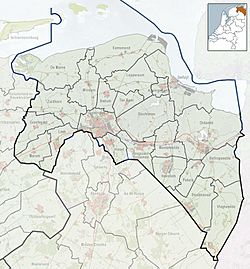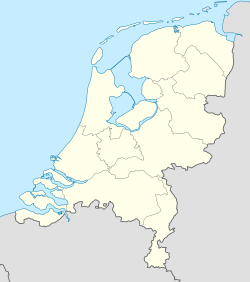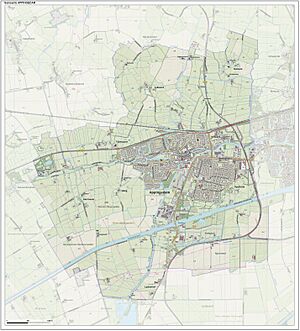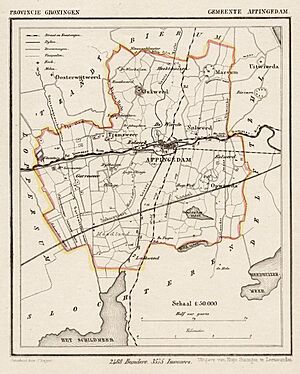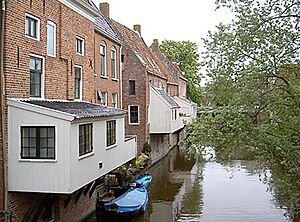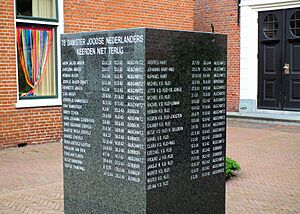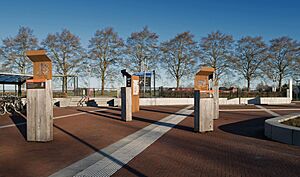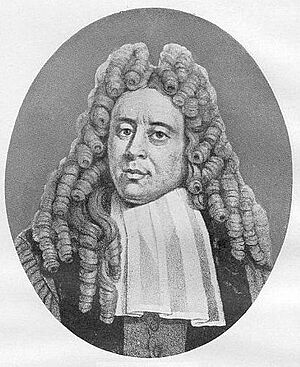Appingedam facts for kids
Quick facts for kids
Appingedam
n Daam (Gronings)
|
|||
|---|---|---|---|
|
City
|
|||
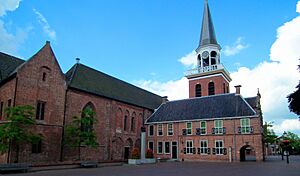
Nicholas Church (left) and renaissance town hall (right) in Appingedam
|
|||
|
|||
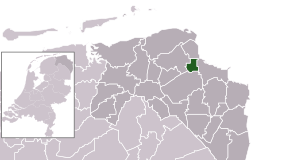
Location in Groningen
|
|||
| Country | Netherlands | ||
| Province | Groningen | ||
| Municipality | Eemsdelta | ||
| Area | |||
| • Total | 24.58 km2 (9.49 sq mi) | ||
| • Land | 23.77 km2 (9.18 sq mi) | ||
| • Water | 0.81 km2 (0.31 sq mi) | ||
| Elevation | 0 m (0 ft) | ||
| Population
(01-01-2023)
|
|||
| • Total | 11.085 | ||
| • Density | 505/km2 (1,310/sq mi) | ||
| Demonym(s) | Appingedammer Locally known as "Damsters" | ||
| Time zone | UTC+1 (CET) | ||
| • Summer (DST) | UTC+2 (CEST) | ||
| Postcode |
9900–9903
|
||
| Area code | 0596 | ||
Appingedam is a city in the northeastern Netherlands. People have lived in this area for over a thousand years. The oldest traces of settlements were found in a part of the city called the Wierde. Today, a narrow street there still shows its long history. The East-West Canal, known as “Diep,” also helps define the city's unique look.
Appingedam started around the year 1200, near a waterway called the Delf (now the Damsterdiep). Its name comes from a dam built in a river called the Appe or Apt. In 1327, Appingedam gained city rights. This meant it could govern itself more freely. Appingedam is located in the Fivelingo region, which was part of Frisia in the Middle Ages.
In the past, Appingedam was an important seaport and trading city. It competed with the city of Groningen. However, when Groningen got special trading rights, Appingedam's trade slowed down. Later, Delfzijl became a bigger seaport.
Today, Appingedam is a charming small city. You can still see many old medieval buildings in its center. The most famous sight is the "hanging kitchens" that stick out over the Damsterdiep canal. Appingedam was also home to the Appingedammer Bronsmotorenfabriek, which made large ship engines.
Contents
- Appingedam's Story: A Look Back
- How Appingedam Began
- A Busy Trading Hub
- The "Neighbour Letter" and City Rights
- Growing and Building
- Challenges with Groningen
- Old Industries of Appingedam
- The Famous "Brons" Engine Factory
- Appingedam After World War II
- Protecting Appingedam's Heritage
- The Damsterdiep's Revival
- Overdiep: A New Chapter
- Places in Appingedam
- Getting Around
- Sports in Appingedam
- Famous People from Appingedam
- Images for kids
- See also
Appingedam's Story: A Look Back
How Appingedam Began
Appingedam grew up along the Delf waterway, now called Damsterdiep, around 1200. The name means "the dam built in the Appe" or "Apt" river. This spot was great for trade because two waterways met there. Ship captains, traders, and craftspeople settled here. Appingedam was first mentioned in a historical paper in 1224. It became one of the two main cities in the Frisian region of Fivelingo during the Middle Ages.
A Busy Trading Hub
Because of its good location near waterways and the sea, Appingedam quickly became a busy center for shipping and trade. Ships would load and unload goods at its two busy docks. This brought a lot of wealth to the city. Goods were stored and traded in Appingedam's markets. Then, they were sent by water to northern Germany, Westfalia, and even the Baltic Sea area. This trade made Appingedam the most important city in Fivelingo.
The "Neighbour Letter" and City Rights
As an important seaport and trade center, Appingedam soon gained official recognition. In 1327, its city rights were confirmed by a group of representatives from seven Frisian sea states. They signed a treaty in Upstalboom, which is now the city of Aurich in East Frisia. The rights and special rules given to Appingedam were written down in a document called the "Neighbour Letter."
Growing and Building
Appingedam continued to grow for the next two centuries. In the 1300s, a large church, a convent, a guesthouse, and two strong castles (Ripperda and Snelgersma) were built. Work on the canals and docks also continued into the 1400s. Even today, you can still see some of these 600-year-old structures along the waterfront.
Challenges with Groningen
However, Appingedam's growth started to cause problems for the city of Groningen. The tension between the two cities led to several fights. In 1536, Appingedam lost a major battle. As a result, the city was damaged and lost its important role in trade and politics. Appingedam's economy slowly declined after that.
There was a small comeback in the 1630s when the City Hall was built. Later, around 1760, some gabled houses were rebuilt. But it wasn't until the late 1700s that the city really started to grow again. Regular train services began connecting Appingedam to other cities. In 1884, a new railway station was built.
Old Industries of Appingedam
Along the Damsterdiep, many businesses grew over the years. These included foundries (where metal is cast), brickworks, sawmills, and other industries. They supported the shipyards or were related to farming in the area. Windmills made flour, and oil presses made oil for local bakeries and traders. Appingedam also had six beer breweries, two gin distilleries, and many other factories.
The Famous "Brons" Engine Factory
The late 1800s brought an economic boost to Appingedam, especially from cattle and horse markets. Even though waterways became less important after the Groningen-Delfzijl railway opened, Appingedam changed. It became a major industrial center.
In 1870, C. Roggenkamp started the first steam-powered sawmill in the Netherlands in Appingedam. Soon, other steam machines were used in factories, making the city even richer. By the early 1900s, Appingedam had a dairy factory, a flax factory, and other plants. The "Bronsmotorenfabriek" (Brons Engine Factory) became famous worldwide. Its founder, Jan Brons, created the first Brons engine for modern ships. Today, you can see a huge part of the first "Source" engine as a monument in the city.
Appingedam After World War II
At the end of World War II, Appingedam suffered a lot of damage from heavy attacks. Many people had to leave their homes. The city was defended by a small group of people for ten days until May 2, 1945, when Canadian troops freed it. When people returned, they found their hometown badly damaged. It took many years to rebuild Appingedam to its current beautiful state.
Protecting Appingedam's Heritage
After World War II, the nearby city of Delfzijl grew very quickly. It became a major port and industrial center. Appingedam's growth was slower. However, in 1972, Appingedam was named a "conservation area." This special status helped the City Council get money and legal power to restore the historic city center. Ambitious plans were made to bring back Appingedam's unique, centuries-old look, and they were put into action quickly.
The Damsterdiep's Revival
Restoring the downtown area, especially around the Damsterdiep, had a big impact. Not only did the city look better, but life in Appingedam also became more lively. With the motto "Appingedam—Back in Service," the council successfully attracted tourists and businesses. The city focused on tourism, especially after the Damsterdiep sailing route opened. Appingedam quickly expanded with modern homes, new shops, and good transportation. Today, Appingedam is a popular tourist spot in Groningen. It has also become a regional center for services, education, and shopping.
Overdiep: A New Chapter
Overdiep is the newest project to update Appingedam. It's a large area with homes, shops, and places for fun. Its design fits well with the old city center. Overdiep is named after the new Diep canal, which separates the old city from the newer parts. It offers great views of the Nicolaïkerk church. In 2009, the first houses were built, along with a health center, a new yacht harbor, and a pavilion. The final part of the complex was finished in 2011.
Places in Appingedam
- Appingedam
- Garreweer
- Jukwerd
- Laskwerd
- Marsum
- Oling
- Opwierde
- Solwerd
- Tjamsweer
Getting Around
Appingedam has its own railway station, called Appingedam railway station.
Sports in Appingedam
Cycling Events
Appingedam has hosted parts of major cycling races. It was the start and finish point for the first stage of the 2012 Energiewacht Tour (an individual time trial). It also hosted the 3b stage of the 2013 Energiewacht Tour.
Famous People from Appingedam
- Perizonius (1651–1715) – A classical scholar, whose real name was Jakob Voorbroek.
- Jan ten Brink (1834–1901) – A Dutch writer.
- Rudolph Cleveringa (1894–1980) – A professor of law at Leiden University.
- Geert Bakker (1921–1993) – A sailor who competed in the 1976 Summer Olympics.
- Leendert Bosch (1924–2017) – A Dutch biochemist and academic.
- Klaas Bolt (1927–1990) – A classical organist and improviser.
- Evelien Koogje (born 1959) – A retired rower who competed in the 1976 Summer Olympics.
- Nathalie de Vries (born 1965) – A Dutch architect, lecturer, and urban planner.
Images for kids
See also
 In Spanish: Appingedam para niños
In Spanish: Appingedam para niños




